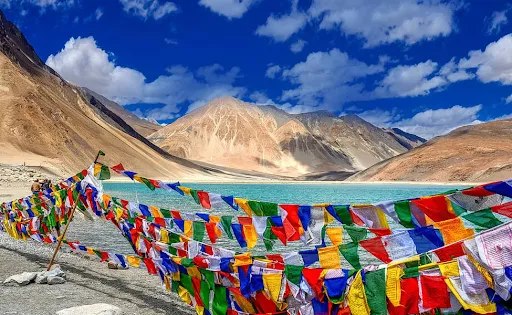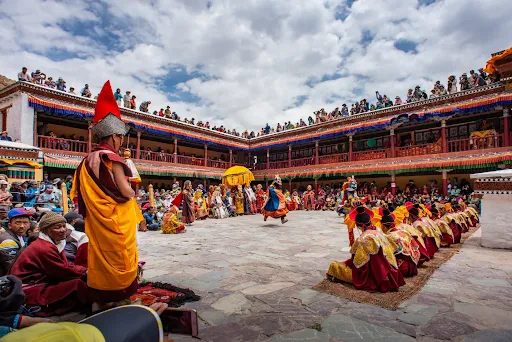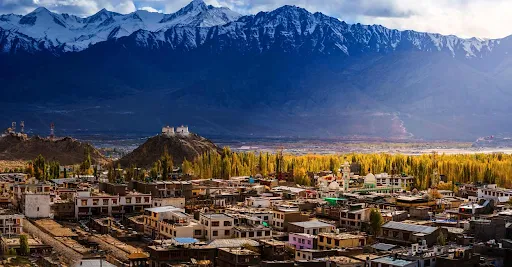Leh Ladakh as a tourist destination offers a unique blend of culture and sightseeing. Whether we talk about Monasteries in Ladakh, Pangong Lake, Ladakhi Cuisine, or its Vibrant Festivals, Ladakh never fails to mesmerize travelers, However, increasing tourism in Ladakh has emerged as a threat to its ecosystem and culture, because of which Eco-Tourism in Ladakh has become a necessity.
Ladakh, often referred to as “Little Tibet,” is one of those destinations that is on every traveler’s bucket list. Known as the “Roof of the World,” Ladakh’s Tibetan Platue is a unique blend of cultural richness and natural beauty. However, the delicate balance of this ecosystem is threatened by uncertain and irresponsible tourism practices. Hence, adopting sustainable travel practices and promoting Eco-tourism in Ladakh is not just a choice but a necessity for the preservation of this iconic destination.
Sustainable Travel: Eco-Tourism in Ladakh: –
1. Discovering Ladakh’s Ecosystems

Ladakh’s diverse and captivating landscapes provide visitors with an insight into the abundance of nature.
Every part of Ladakh, from the wild lands of the Zanskar Range to the serene shores of Pangong Lake, has a unique beauty in it.
Rare wildlife species, including the elusive snow leopard and the Tibetan wild ass, or kiang, can be found in the high-altitude desert of the region.
Meanwhile, centuries-old local villages are filled by the apricot and barley orchards that thrive in the rich valleys.
Ladakh’s ecology is a haven for both conservationists and nature lovers.
For those looking for a more immersive experience in the out in nature, trekking routes in Ladakh provide an opportunity to get closer to nature.
Trekkers looking for adventure and cultural immersion often choose the Markha Valley Trek, which is famous due to its breathtaking views and hidden villages.
On the other hand, easy access to gorgeous scenery without difficult climbing is possible via nature trails around Leh.
2. Sustainable Travel Practices
Considering eco-tourism in Ladakh has become an important subject because of which, exploration is now driven by sustainable practices.
It includes making thoughtful choices that respect regional traditions and customs while reducing environmental harm.
The three pillars of eco-tourism in Ladakh are environmental, social, and economic sustainability, and are the core of responsible travel.
It includes cutting down on waste, preserving resources, helping out the community where you live, and respecting indigenous cultures.
the practices of eco-tourism in Ladkah are made possible by minor choices like bringing reusable water bottles, booking eco-friendly lodging, and hiring local guides.
Dressing appropriately and asking permission before taking pictures of individuals or places also come under sustainable practices.
Choose accommodations that prioritize eco-friendly practices and public transportation like cycling, or walking whenever possible can reduce environmental damage.
3. Responsible Cultural Immersion

The diverse cultural legacy and traditions of Ladakh are what truly define the region, even beyond its stunning scenery.
Travelers can have a greater insight into the history and way of life of the area by interacting with the local people.
Ladakh’s cultural landscape is a combination of influences from indigenous Bhotia people, Central Asian nomadic tribes, and Tibetan Buddhism.
Ancient traditions and festivals honor the region’s various faiths in monasteries like Hemis, Thiksey, and Diskit, which serve as spiritual centers.
Ladakh’s cultural history may be seen in traditional art forms including thangka painting, elaborate woodwork, and in its festivals.
If you want to fully experience Ladakh culture, you can book a homestay with a native family, from which you will have an eco-friendly option because most of the homestays in Ladakh promote sustainability by recycling energy and using locally produced vegetables.
This not only provides an authentic glimpse into daily life but also directly supports the community.
4. Thrilling Adventures in Nature
The untamed environment and rough terrain of Ladakh provide an incredible environment for thrill-seekers looking for adventure activities among magnificent scenery.
Ladakh offers thrilling adventure sports including paragliding, mountain biking, and river rafting.
With gentle to difficult rapids, river rafting on the Indus and Zanskar rivers is an exciting way to take in Ladakh’s breathtaking scenery.
Mountain bikers can enjoy breathtaking vistas of the Himalayas as they travel through valleys and mountain passes on high-altitude trails.
With skilled pilots leading you into the sky for a once-in-a-lifetime experience, paragliding provides a bird’s-eye view of Ladakh’s breathtaking scenery.
Blending adventure activities and Ladakh eco-friendly travel practices should always be a priority.
By sticking to authorized routes while minimizing every kind of pollution, you can show respect for the ecosystems, Ladakh eco-friendly travel practices, and nature conservation in Ladakh.
Take care of all trash and follow the concept of “Leave No Trace” to ensure that Ladakh’s clean environment is preserved for future generations.
5. Supporting Nature Conservation in Ladakh
Ladakh’s delicate ecosystem needs to be preserved, and both residents and visitors must work together to achieve this.
Travelers can help significantly to the preservation of the area’s natural heritage and biodiversity by supporting nature conservation in Ladakh and Ladakh eco-friendly travel practices.
In Ladakh, there are numerous community-led projects and organizations committed to the conservation of wildlife to sustainable farming methods.
Initiatives like community-based tourism and snow leopard conservation help communities live in sync with their natural environment by reducing conflicts between humans and wildlife.
Developing a sustainable future for Ladakh also requires promoting renewable energy sources and cutting down on plastic waste.
Travelers who volunteer with local environmental organizations or take part in community-based projects can make a significant contribution to conservation efforts in Ladakh.
Additionally, choosing eco-friendly businesses and purchasing locally made handicrafts directly support the region’s economy while promoting sustainable practices.
Conclusion:
By embracing Eco-tourism in Ladakh, engaging with local communities, and supporting conservation efforts, travelers can make a positive impact on Ladakh’s ecosystem. Ladakh eco-friendly travel is not just about sightseeing, it’s about respecting the rich heritage of the land and its people



